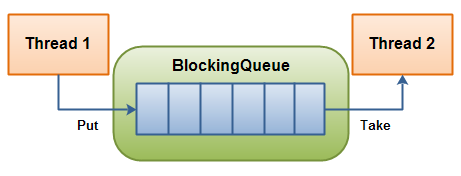Java Concurrency Tutorial
In simple words, concurrency is the ability to run several programs or several parts of a program in parallel. Concurrency enable a program to achieve high performance and throughput by utilizing the untapped capabilities of underlying operating system and machine hardware. e.g. modern computers has several CPU’s or several cores within one CPU, program can utilize all cores for some part of processing; thus completing task much before in time in comparison to sequential processing.
The backbone of java concurrency are threads. A thread is a lightweight process which has its own call stack, but can access shared data of other threads in the same process. A Java application runs by default in one process. Within a Java application you can work with many threads to achieve parallel processing or concurrency.
BLOCKINGQUEUE
http://amitpreet.com/JavaTutorials/collectionsPdf.xhtml
A blocking queue is a queue that blocks when you try to dequeue from it and the queue is empty, or if you try to enqueue items to it and the queue is already full. A thread trying to dequeue from an empty queue is blocked until some other thread inserts an item into the queue. A thread trying to enqueue an item in a full queue is blocked until some other thread makes space in the queue, either by dequeuing one or more items or clearing the queue completely.
Here is a diagram showing two threads cooperating via a blocking queue:
Java 5 comes with blocking queue implementations in the
BlockingQueue
A blocking queue is a queue that blocks when you try to dequeue from it and the queue is empty, or if you try to enqueue items to it and the queue is already full. A thread trying to dequeue from an empty queue is blocked until some other thread inserts an item into the queue. A thread trying to enqueue an item in a full queue is blocked until some other thread makes space in the queue, either by dequeuing one or more items or clearing the queue completely.
Here is a diagram showing two threads cooperating via a blocking queue:
 |
| A BlockingQueue with one thread putting into it, and another thread taking from it. |
java.util.concurrent package. You can read about that class in my java.util.concurrent.BlockingQueue tutorial. Even if Java 5 comes with a blocking queue implementation, it can be useful to know the theory behind their implementation.Blocking Queue Implementation
The implementation of a blocking queue looks similar to a Bounded Semaphore. Here is a simple implementation of a blocking queue:public class BlockingQueue {
private List queue = new LinkedList();
private int limit = 10;
public BlockingQueue(int limit){
this.limit = limit;
}
public synchronized void enqueue(Object item)
throws InterruptedException {
while(this.queue.size() == this.limit) {
wait();
}
if(this.queue.size() == 0) {
notifyAll();
}
this.queue.add(item);
}
public synchronized Object dequeue()
throws InterruptedException{
while(this.queue.size() == 0){
wait();
}
if(this.queue.size() == this.limit){
notifyAll();
}
return this.queue.remove(0);
}
}
Notice how notifyAll() is only called from enqueue() and dequeue() if the queue size is equal to the size bounds (0 or limit). If the queue size is not equal to either bound when enqueue() or dequeue() is called, there can be no threads waiting to either enqueue or dequeue items.
No comments:
Post a Comment